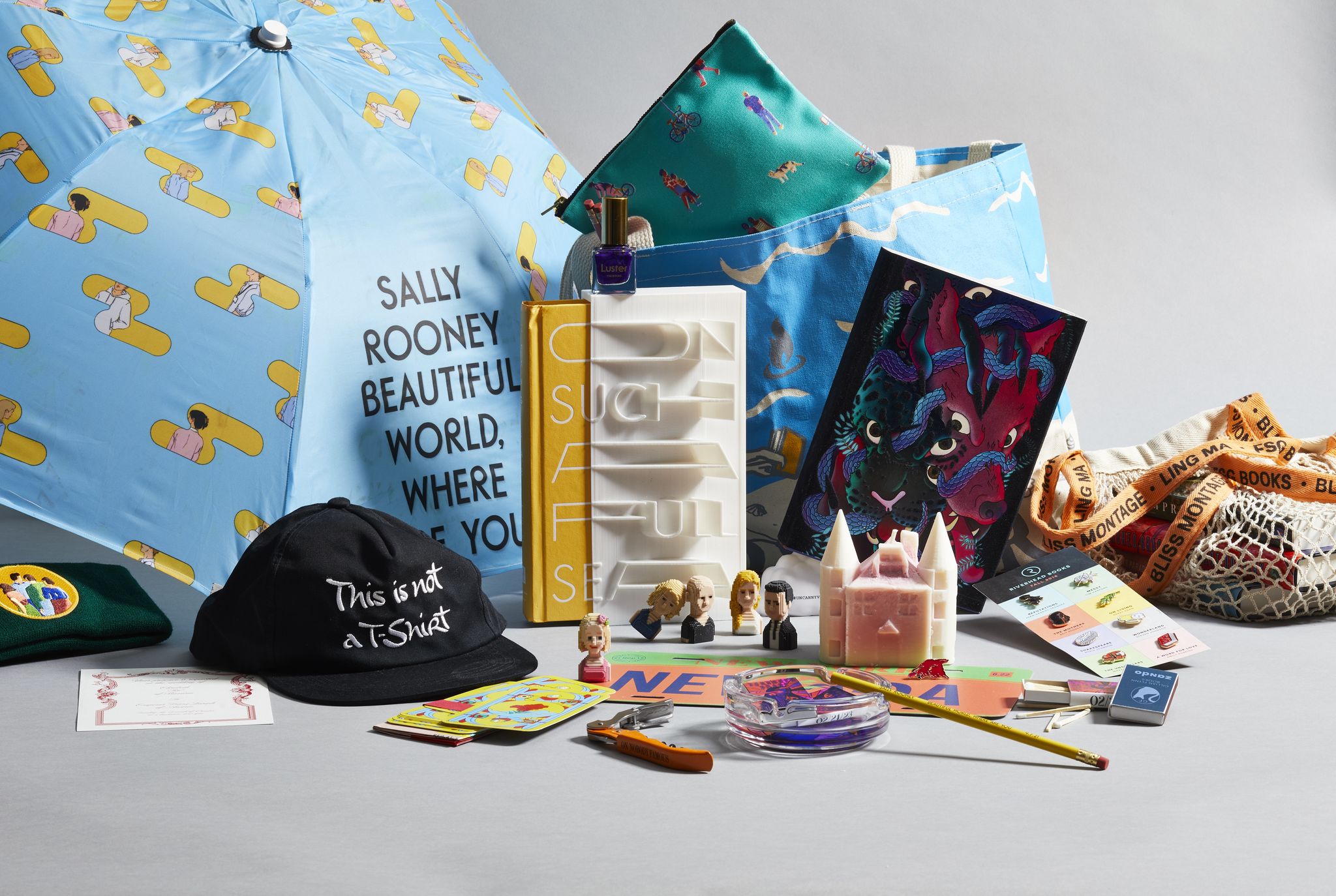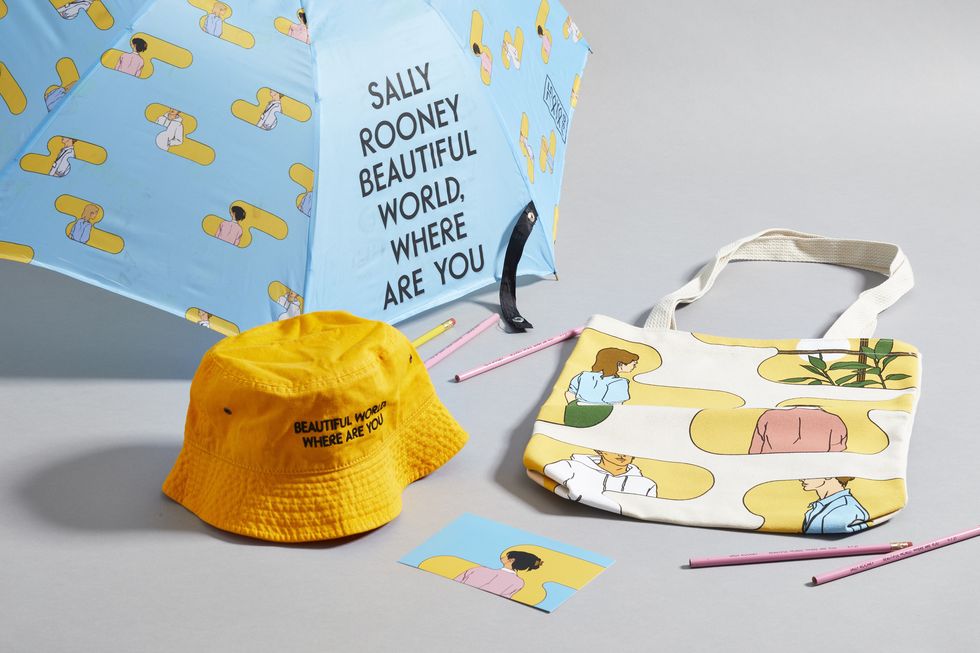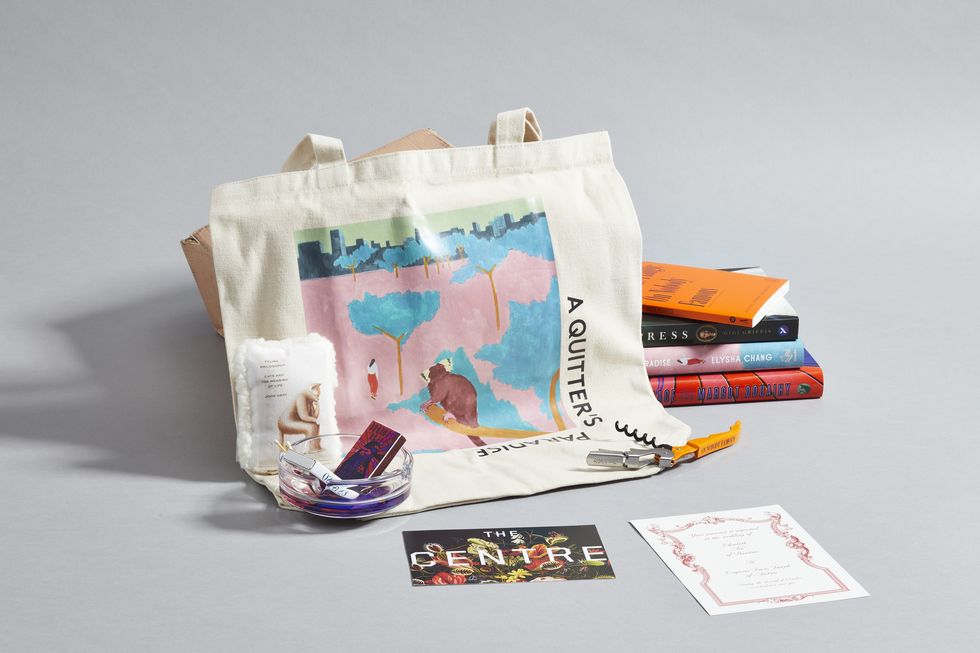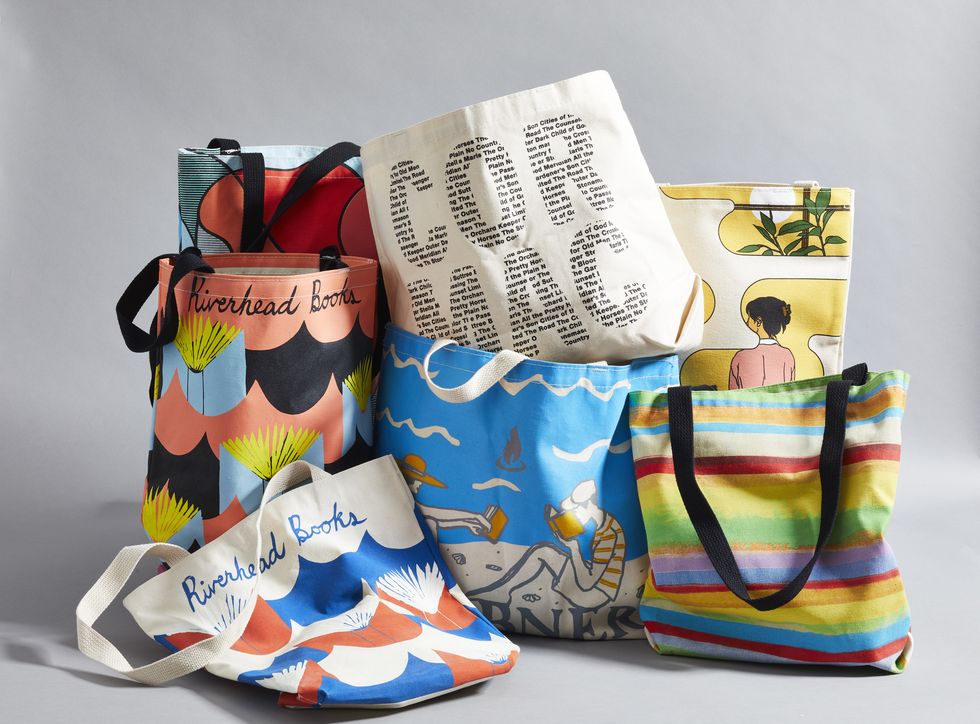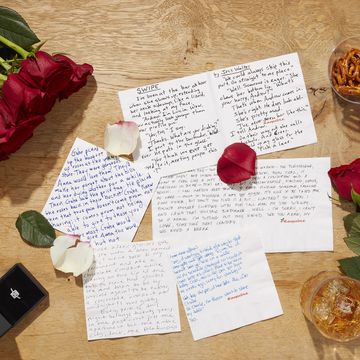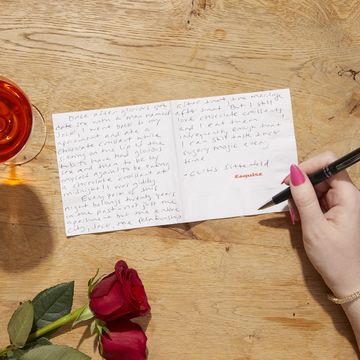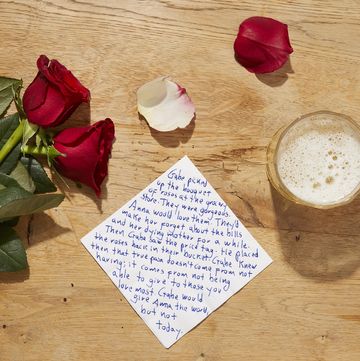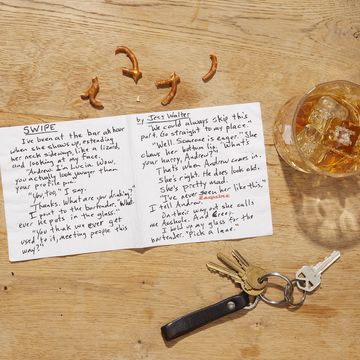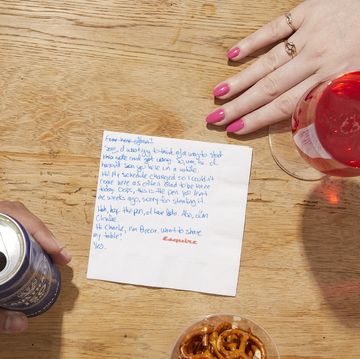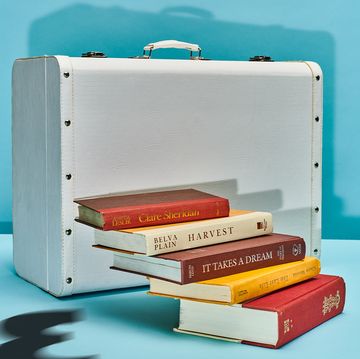For most readers, acquiring a newly released book means heading to your local bookstore, hitting the library, or logging on to Amazon. For others, however, it involves opening up a thoughtfully designed box that includes a copy of the book, alongside gifted items like a custom tote bag, a scented candle, beauty products, and maybe even a box of tea. If you’re a book influencer, the latter is often the case.
One might say that Sally Rooney started it all when it comes to covetable book merchandise that takes over the internet, though she’d likely reject that attribution. I anxiously awaited the release of Rooney’s latest novel, Beautiful World, Where Are You back in September 2021. I placed my pre-order at my local bookstore because, at the time, I thought that this was all a reader could do. Oh, how wrong I was! Leading up to publication day, I started seeing authors, journalists, and generally cool internet people post about the Beautiful World tote bag and the Beautiful World bucket hat and even the Beautiful World umbrella. Although sometimes, as a writer, I receive an ARC or a promotional bookmark (for these, I am grateful), I knew there was no way I was getting my hands on any of that premium merch. Instead, I showed up at a coffee cart pop-up in Fort Greene, Brooklyn, (sponsored by AirMail and Farrar, Straus, and Giroux, Rooney’s publisher) and won myself a tote bag the old fashioned way—by answering a Rooney-themed trivia question correctly. (“What’s the most commonly consumed beverage in the world?” Tea, of course).
In the months after the book’s release, the tote was often a conversation starter around New York City. When I stopped by a bookstore, sometimes I’d get a comment from a bookseller about the merch frenzy. A few writer friends asked how I managed to get my hands on one, while strangers who didn’t know about the book even commented on its beautiful design. It was a noticeable reaction for a simple canvas bag. In the year and a half since Beautiful World and the merch-induced frenzy of its release, the promotion of books via social media marketing and influencer relations has become even more elaborate. Now, many publicity and marketing campaigns are created with influencers in mind, with TikTok video-worthy PR boxes and branded swag that’s designed to create a social media moment upon a book’s publication. The question, then, isn’t if influencer culture is changing book marketing and publicity, but how.
Emma Cline’s latest novel, The Guest, published on May 9. In preparation, Cline’s publisher, Random House Books, distributed advanced reader copies (ARCs) to book influencers, packaged alongside a tube of Supergoop sunscreen, a box of Tate’s Bake Shop cookies, a pair of sunglasses color-coordinated to the book’s cover, and a handful of other goodies, all aptly themed around the novel, which takes place at the end of summer on the East End of Long Island. The influencer mailing also came with a coveted Random House Books tote bag. Marisa Gates, the content creator behind the TikTok account “smallcasualbooktok,” posted a 15-second-long video displaying the contents of the box in February, remarking that The Guest is her most anticipated book of the year. The views, and the enthralled readers in the comments, quickly followed.
“I wish all books came like this,” read one comment. “I have never been more jealous of anyone ever,” read another. Gates, who later posted a full review of the novel in a separate video, never anticipated that her platform would grow to this size, or that she’d receive these types of responses. In fact, she told me that, “as someone who is anti-capitalism and [anti-]overconsumption,” her goal when starting her account was to show how one can build their book collection by using the public library and buying books secondhand. After nearly two years on TikTok, she now has nearly 6,000 followers on the platform. Book publishers frequently pitch her on forthcoming titles to review, which are often sent with accompanying swag, including items customized to reflect a book’s title or cover art, as well as related products from other brands that fit with a book’s theme, e.g. the Tate’s cookies, a brand founded in Southampton, N.Y.
Gates is far from the only influencer receiving this book merchandise. Search “book PR package” or “book PR haul” and you’ll find videos with tens of thousands of views (if not more). Commenters passionately express their interest in the books at the center of these videos, as well as their jealousy about the accompanying totes and T-shirts. Gates even quipped that some of her followers say she’s on their “rob list,” indicating that they’d love to steal all the swag she receives from publishers. Clearly Bookstagrammers and BookTokers have not only commanded the attention of other readers on their respective platforms, but also that of major publishers and authors.
Even though she’s been receiving influencer packages since 2021, Gates is still impressed by the novelty of it all: “I’m honestly just shocked I get them,” she said. That said, Gates is intentional about what she posts, and she declines ARCs and influencer boxes for titles that don’t appeal to her. “I don’t want to have that pressure on me to read something I wouldn’t read,” she said. “Plus, it strikes me as almost pretextual…[if] I’m showing this PR package for a book that I’m not going to read.”
Zoë Jackson, another book content creator, agreed, telling Esquire that having a solid sense of one’s own literary taste is a key part of being a book influencer. “If you're going to talk about books online, you need to know what you like,” Jackson said. “And that involves saying no to stuff.”
On the publisher side, intentionality is also a key element of marketing strategies. “I put a great deal of consideration into who receives each title in hopes of sending them their next favorite read,” said Amelia Olsen, a marketing coordinator at Zando Projects, an independent publisher known for the buzzy (and often cheeky) merch they send along with their new releases, such as an ashtray and a matchbook featuring the cover art of Margot Douaihy’s Scorched Grace, a novel about a chain-smoking, tattooed nun who becomes a sleuth investigating an arson spree at her school. Olsen and Chloe Texier-Rose, the head of publicity at Zando Projects, declined to answer questions about how they select just who receives these packages, though Olsen noted that their model “harnesses the power of beloved public figures, platforms, and institutions to promote our books.”
Douaihy, a debut author, was thrilled about the ashtray and matchbook, noting that the marketing team at Zando Projects asked her questions such as, “What kind of feeling do you want [the merchandise] to embody?” As for the merch itself, Douaihy calls it “astoundingly creative.” She recalls particular excitement from readers and booksellers surrounding the matchbooks, which look like miniature versions of her novel, especially because “fire and ignition and incineration and arson are themes in Scorched Grace,” she said. At a recent birthday party Douaihy attended, a friend had displayed one of the matchbooks in her home, and it garnered instant curiosity from fellow guests. “All these people were gathering around it, [asking] ‘What is that? How can I get one? Where can I buy one?’” Douaihy added, “The more digital we all are, little things that are tangible and unique have a lot of currency.”
This is why she believes readers are so drawn to book-related merchandise, whether they see it online from an influencer or at their local bookstore. In fact, she’s brought matchbooks to signings at bookstores and recalls that they’ve quite literally sparked conversation, while offering “new ways to bring the characters to life, and even the danger [of the novel] to life.” While a branded ashtray or matchbook may seem small, Douaihy said that these thoughtful touches to her book launch are an indication that Zando is providing “more ways and more tools to enhance the community aspect [of reading].”
It’s not surprising that TikToks showcasing ARCs and gifted items from publishers, particularly of highly anticipated titles, are so enticing to viewers, especially those on “BookTok,” the niche community that includes everything from book reviews to library hauls to roundups of “books I would sell my soul to read again for the first time.” Haul videos, in which creators flaunt items they’ve recently bought or been gifted, have been captivating internet audiences for years, especially in the fashion and beauty space, so why would it be any different for book lovers? With book-related content, though, these videos usually revolve around a book review or a recommendation. At the very least, the coveted branded tote bag or book-themed t-shirt offers an enticing visual pairing, or at most, a viral moment for a new release.
“I really appreciate when [a PR package] is centered around the book or themes in the book,” Gates said, noting that the sunscreen included in the package for The Guest felt relevant in more ways than one. The book deals with themes of class in the Hamptons, and the characters in the novel are, according to Gates, “these upper class people who don’t really know what’s going on. Those people I would guess would be the most likely to use Supergoop sunscreen,” she remarked.
Dakota Bossard, who creates book-themed content on TikTok and Instagram, said that influencer PR materials from publishers and marketing agencies help the content she’s already creating come alive—if they’re done right. “As someone who does more aesthetic-based videos, it’s so helpful to receive a nice box with nice packaging from top to bottom,” she said, adding that the contents of a PR box from a publisher or marketing agency help her film B-roll that’s “perfect for book reviews.”
What actually makes good book merch within these curated packages? According to Bossard, items one can actually use are what impress her most. She prefers “things that are well designed,” and “things I’m not just going to shove into a drawer.” She mentioned a book-themed election button included in a PR package for a title in which an election is a major plot point, and while the design was admirable, it quickly found its way into a drawer and out of sight. That’s where the tote bag comes in. At a time when practically every brand has its own canvas tote, it’s an easy in for publishers to create a practical item that will get plenty of facetime with potential readers. “Instead of a baseball cap for sports fans, it’s a tote bag for book fans,” said Sydney Czech, a former library marketing coordinator at a Big Five publisher (the “Big Five” is comprised of Hachette, Harper Collins, Macmillan, Penguin Random House, and Simon & Schuster).
But a beautiful cover and clever PR materials do not always make for a five-star read. Influencers are then tasked with the question: should I post about a book I didn’t enjoy? “My personal best practice is to wait until I’ve read the book and then include the unboxing in my review video,” Bossard said. Jackson has also faced this question, remarking that when she receives an influencer box, she’ll typically opt for a lower-stakes post, like a photo on Instagram stories, and wait until she’s read the book to give a full review on TikTok, ultimately keeping the merch and the review separate. When she does post an Instagram story, her followers will send direct messages expressing excitement about a forthcoming review.
BookTok and Bookstagram feel markedly more deliberate and more curated than other internet niches, in part because many content creators have done the work of reading an entire book before posting about it, and are often only sharing the books they absolutely love (or, for some, the ones they absolutely detest). However, when an influencer does post solely about the merchandise, with no promise of a review or recommendation, the viewer is faced with the question: How do I know if this book is any good? Can I trust this person? Are they just here for the vibes and not the literature? Aesthetically pleasing book covers, including “blob covers,” which feature colorful, abstract designs, have had a chokehold on the publishing industry for the last several years. Coincidentally (or not), they look terrific in ambient TikTok videos or carefully staged Instagram posts. But for consumers of book content on social media, a level of trust from the influencer is necessary to keep following, whether that’s in the form of a review or an influencer’s indication that they’ve read this author before and are therefore excited about their latest work. A pretty flat lay of an art print-worthy book cover and an accompanying tote bag doesn’t tell viewers much about what’s between the covers.
With that in mind, most book launch-related promotional merchandise appears well curated, if sparse. The influencer box for The Guest that Gates received, for example, wasn’t overflowing with goodies (or an excess of packing peanuts and confetti). Jackson also mentioned that the influencer packages she prefers are filled with “things that complement what the book's actually about and also things that aren't super wasteful,” referencing the current discourse on how wasteful influencer packages can be. Bossard also takes packaging into account when describing what makes appealing PR materials, noting that she enjoys a branded box or envelope, “as long as they are recyclable and easy to break down, most of which are.” However, “the confetti is a nightmare,” Bossard said, though “tissue paper is easier to reuse or dispose of, and it's pretty in photos and videos.” When it comes to what’s inside these mailers, Bossard has received quite a few items “that are a bit too specific to the book that I have no interest in using and end up keeping in the bottom of a drawer, which feels so wasteful.” She added, “It feels even worse when I don't like the book.”
Though book influencers may vary in approach, they generally do one thing well: they make reading look fun and stylish, and clever merch certainly adds to that air of an aspirationally literary life. In February 2023, Barry Pierce wrote about “the shallow world of BookTok” for British GQ, where he describes how as a former Youtube content creator (a BookTuber, as he calls it), he feels partly responsible for the popularity of aesthetics-based, anti-intellectual reading content on TikTok. He’s not entirely off-base; he’s right that content creators who focus on books succeed in making a lifestyle in which reading is at the center look appealing and achievable, perhaps more achievable than it really is. But where I believe he’s wrong is his argument that book content creators aren’t contributing to literary discourse. Plenty of BookTok videos include detailed reviews with analysis of major themes and plot points, and creators provide thoughtful recommendations based on themes, writing style, and other pop culture preferences.
Similarly, Sweetbitter author Stephanie Danler lamented in Bustle that BookTok doesn’t offer a genuine space to be a reader; rather, she argued, it encourages one to look like a reader. Literary publicity teams who make promotional materials, especially ones that are ultimately disposable (like t-shirts and tote bags), could be accused of commodifying art. Influencers are helping sell books, after all. “I don't think selling books is a bad thing, because it's the goal of the entire publishing industry, of which we are an adjacent arm—we rely on them for books to read, and they rely on us to help these books find their target audience,” said Stacey Yu, a book content creator who noted that she balances her literary diet between large and indie presses. Yu pointed out that big publishers “are able to send out more PR boxes, pay for sponsored videos, work with PR firms who specialize in influencer marketing, and devote more time to strengthening their influencer outreach programs,” as opposed to indie presses with fewer resources that can’t always pay creators for their work. This disparity is apparent on social media, where big publishing houses (and social-forward ones like Zando Projects) boast feeds full of merch, giveaways, and influencer partnerships, while independent presses like Tin House and Graywolf Press have far more straightforward online presences.
Publishers that do lean into social media, with the help of book influencers, are meeting readers where they are. At a time when readers' crucial third places (like bookstores, public libraries, and book clubs) are just starting to return after the COVID-19 pandemic, social media has remained a haven of connection for book lovers. Luddites might scoff, but the same people who once sat for hours in bookstores poring over new releases (and who still do) are now on TikTok. Literary conversations may finally be happening in person again, but they’re still happening online, too.
“Word of mouth has always been the hero of book promotion,” Olsen said. “So when a creator uses their platform to champion a book or author, it’s invaluable.” Just as social media has changed the game for readers, it’s also had a significant impact on the publishing industry. According to Olsen, “influencer management and relations have become a huge part of what we consider when creating a marketing campaign.” Because so many influencers post about the swag they receive, whether it’s in a simple unboxing or a full review, the incentive to provide social media-worthy materials remains high.
Book merch has more social currency than ever, but publishers don’t always get it right, as evidenced by the coloring book based on Colleen Hoover’s It Ends With Us. The book garnered an apology from Hoover and the cancellation of its publication after social media users called it out for being tone-deaf, as the novel is largely about domestic violence. Some authors leverage their own social followings to reach readers, even when they have the backing of a big publisher. Haley Jakobson, whose debut novel, Old Enough, came out in June with Dutton Books, had creative control when it came to designing her PR boxes while working alongside her marketing team at Penguin Random House. She also decided who would receive them, noting that she’s been excited about her PR boxes ever since she was still in the process of writing the novel. The influencer box for Old Enough includes a variety of “campus essentials” that coincide with themes in the book, including “your first ever vibrator” from Bellesa, a Papier notepad for class notes, and hand-sewn vintage fabric scrunchies from Miranda Watson Design. The author herself partnered with brands and small business owners to supply the items in each of the 100 carefully curated boxes. “It all comes from relationships that I’ve been developing for years. And I have very much always had my eye on the prize with those relationships,” she said.
Jakobson’s role as a “writer on the internet,” as she puts it, also plays into why she decided to lean heavily on PR boxes and influencer promotion for her book launch. “I knew that the driving force of selling this book would be to really dig into the thing that I am good at and that I love, which is social media,” she said. Similarly, in choosing who would receive the PR boxes, intentionality was key. “I wrote a queer book,” she said of the novel, which tackles the nostalgia of girlhood, acknowledging oneself as a survivor of sexual assault, and friendship loss. “So that’s why many of the people on my PR list are gay or survivors.”
With the rise of BookTok and Bookstagram, influencers across different platforms have virtually created a new form of book publicity—so it’s no surprise that some authors have joined in. No matter how you feel about the role of social media and influencers in the literary world, they’ve had an undeniable effect on the industry writ large.
But there’s an air of exclusivity that looms in the book influencer community. Some creators post about a book and include a photo or video of the ARC, while others will showcase the elaborate gift box and whatever goodies it may include. The discrepancy insinuates a tiered system of influencers, i.e. who is cool enough (and has enough followers, for that matter) to receive the best merch.
“The BookTok community is so close-knit, so we are all very aware of who is receiving what,” Bossard said. When she first started posting on TikTok in 2021, she noted that she would typically receive an ARC, while watching as influencers with more followers received extra swag. But as her following grew, “I started receiving a more personal touch (and more merch) from certain publishers,” she said. “It became clear that they tend to equate our value with the number of followers we have rather than our reading taste, which is so unfortunate.” Several of the influencers I spoke to echoed the idea that it can be difficult to understand what publishers want, and building personal relationships with marketing and publicity professionals who learn to know their tastes is mutually beneficial.
Zando Projects appears to take an influencer-first approach with its publicity. Three of the book influencers I interviewed mentioned the publisher and their creative publicity campaigns, including ones with clever promotional materials, like the aforementioned ashtray and a beach towel featuring the cover art of The Odyssey by Lara Williams. But these coveted materials aren’t just for influencers; in fact, many publishers offer giveaways via email and on social media, where the prize isn’t just the book, but also the merch. This can range from straightforward (FSG’s Birnam Wood by Eleanor Catton included a copy of the book, an embroidered hat with the book's title, a plantable bookmark, and a pencil) to more elaborate (Zando Projects’ Monstrilio by Gerardo Sámano Córdova included a signed copy of the novel, an illustrated letter from the author, a magnet, an art print featuring images from the book, and a handmade dogwood flower).
While the exclusivity of these items is part of their appeal, it’s possible that their sudden prevalence is also opening up the historically exclusionary publishing industry to readers and writers who might not otherwise have a way in. Olsen said her goal, and that of Zando Projects, “is to make the recipient immediately intrigued,” adding that “a good book box is a world-building experience that starts as soon as the package arrives at our readers’ doorsteps.”
Book influencers have been criticized for making reading into an aesthetic, encouraging followers to be someone who looks like a reader rather than someone who actually reads. But publishers and marketing agencies have played the game too, providing everything an influencer needs to make a book look appealing enough to buy (or at least put on hold at the library).
At the root of much of this content is an honest review from someone who has read that book, and likely many, many others. Does the gift of a pretty tote bag influence that review? Perhaps, for some. But for influencers who create content because they sincerely love books (and readers who stumble across book merch by happenstance, like me), promotional items act as the ultimate seal of approval. After all, what true book lover carries a tote plastered with the title of a book they only rated two stars on Goodreads?
